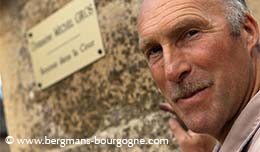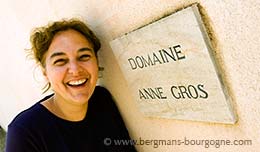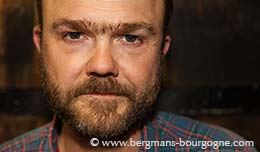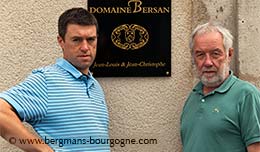
ierrick Bouley in Volnay loves the character whole-bunch fermentation brings to a wine. But it is not a technique he is using. Instead he applied organic practices and changed how things are done in the vineyards.
– Since I’m the sixth generation the vines have an average age of 60 years. So generally the vines of the domaine are old, sometimes very old. There is a better balance between sugar and acidity. It keeps the freshness. The pips are ripe. The stems as well, even if we de-stem 100 per cent. I get everything I love from whole bunches, without doing it. So I think the quality of the wines is much better than before.
Previously the domaine carried the names of Pierrick Bouley’s parents, Réyane and Pascal. Starting with the 2020 vintage it now says Domaine Pierrick Bouley on the labels.
– I run the domaine with my wife since 2023, he says. My parents are retired. I arrived at the domaine in 2009 and I took on the vinification from the 2014 vintage, without really changing much.
 Then came the 2016 vintage, when the frost took 70 per cent of the crop. This called for changes and from then on much was done differently at Domaine Pierrick Bouley. The organic practices were already in place since 2015, even if it would take until 2023 before the domaine became certified organic.
Then came the 2016 vintage, when the frost took 70 per cent of the crop. This called for changes and from then on much was done differently at Domaine Pierrick Bouley. The organic practices were already in place since 2015, even if it would take until 2023 before the domaine became certified organic.
– Since 2017 we prune later in order to delay budbreak. In 2021 we only lost 20 per cent because of the frost. So it does work better. Since 2020 there is no more rognage (hedging, leaf clipping). Instead we use tressage (braiding of the shoots). We stopped rognage because it means less stress for the vines. We did some experiments in 2017, a bit more in 2018. By 2019 we used it for half the domaine and for all vineyards in 2020. This sets us apart from other domaines. Some use tressage for some vineyards, but we do it from our Bourgogne Passetoutgrain up to the premier crus.
Pierrick Bouley is happy with the results, but points out that switching to organic farming is a time-consuming process.
 – What you have been doing for the past ten years is what you harvest. The change is in the plant, in the roots. It is not something that happens immediately. The problem is when you make changes in the vineyard you don’t see the results until two years later, when the wine is in bottle. You don’t know how long it will take before you see results, but you see the wines change, behave differently.
– What you have been doing for the past ten years is what you harvest. The change is in the plant, in the roots. It is not something that happens immediately. The problem is when you make changes in the vineyard you don’t see the results until two years later, when the wine is in bottle. You don’t know how long it will take before you see results, but you see the wines change, behave differently.
– There are parcels we took on after the 2022 harvest, where weedkillers had been used since forever. Two years later the soil was a little bit better, but it requires a lot more time.
With this being Burgundy, known for its small parcels of vines, going up the organic route does provide some challenges. When the parcels are small, even tiny, what your neighbour does can have a big impact on you. This is one of the reasons why Pierrick Bouley started with organic farming, but hesitated when it came to certification. Eventually it was requests from clients that made him go ahead.
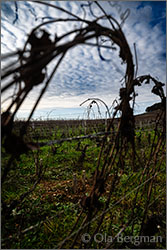 – We have parcels with just four, six or eight rows of vines. Obviously if my neighbours are traditional winegrowers there can't be any wind whatsoever when they spray. I started with organic because in Volnay we have banned the use of weedkillers in the premier crus. It is an ongoing experiment since 2022.
– We have parcels with just four, six or eight rows of vines. Obviously if my neighbours are traditional winegrowers there can't be any wind whatsoever when they spray. I started with organic because in Volnay we have banned the use of weedkillers in the premier crus. It is an ongoing experiment since 2022.
– Our aim is to make Volnay well-known in the whole world. Not one particular producer or another. The idea is to put the appellation first. If somebody tastes a very good Volnay they should be able to taste another from another producer and find it equally good. At this point I think at least half of my neighbours work organically.
– My father had stopped using weedkillers already 25-30 years ago. But it was still conventional farming. In a good year organic farming works very well. In less good years it is less good, but at least slightly better than conventional.
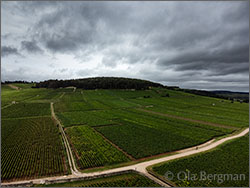 Harvest is done by hand, in small cases which holds 13 kg of grapes. Each harvest worker puts the grapes directly in to the case, then it is immediately sent off to the cuverie. It is 100 per cent de-stemmed and no sulfites are used during vinification or élevage. And as already mentioned, all wines, whether it is a Passetoutgrain or a Volnay premier cru, are produced in the same manner
Harvest is done by hand, in small cases which holds 13 kg of grapes. Each harvest worker puts the grapes directly in to the case, then it is immediately sent off to the cuverie. It is 100 per cent de-stemmed and no sulfites are used during vinification or élevage. And as already mentioned, all wines, whether it is a Passetoutgrain or a Volnay premier cru, are produced in the same manner
– Our Passetoutgrain is from parcels at the bottom of Volnay, says Pierrick Bouley. It’s a large parcel where we have gamay and pinot noir, as well as aligoté. It was planted by my great-grandfather. It was his vineyard for wines for daily consumption. Today we bottle and sell it, but before it was for the family. The proportions for the Passetoutgrain are 70 per cent gamay and 30 per cent pinot noir. The vines are around 80 years old, but they still produce 25-30 hl/ha.
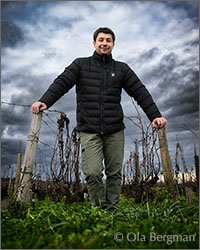 The Bourgogne Côte d’Or comes from the same part of Volnay. It is a blend from two parcels covering two hectares together. One is immediately below the village appellation Volnay, southeast of the village, but still on the ”right” side of the D974 road, while the other is further out in the plain.
The Bourgogne Côte d’Or comes from the same part of Volnay. It is a blend from two parcels covering two hectares together. One is immediately below the village appellation Volnay, southeast of the village, but still on the ”right” side of the D974 road, while the other is further out in the plain.
– When you go from Beaune to Meursault you have village appellations on your right and regional Bourgogne on your left. What makes Volnay a bit peculiar is that there is some regional appellation on your right. This part is frequently touched by frost, so it is not a question of quality of wine or soil. It is very good terroir for Bourgogne, but it is notorious when it comes to frost.
The majority of the vineyards of Domaine Pierrick Bouley are in Volnay. In addition to that there are some vineyards in Pommard, Beaune, Aloxe-Corton and Monthelie. The total surface area of the domaine is twelve hectares.
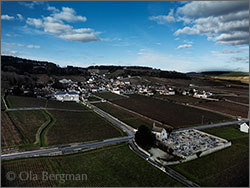 – Monthelie is an interesting terroir, says Pierrick Bouley, because it’s slightly less sunny than Volnay and Pommard. It’s an appellation for the future. We have both village appellation Monthelie – Aux Fournereaux – and premier cru – Les Clous. Today the grapes ripen well. In Aux Fournereaux the soil is a bit like the bottom of Volnay. More clay than limestone. The main difference is the location. It’s Monthelie, so it’s less sun, it’s behind Meursault.
– Monthelie is an interesting terroir, says Pierrick Bouley, because it’s slightly less sunny than Volnay and Pommard. It’s an appellation for the future. We have both village appellation Monthelie – Aux Fournereaux – and premier cru – Les Clous. Today the grapes ripen well. In Aux Fournereaux the soil is a bit like the bottom of Volnay. More clay than limestone. The main difference is the location. It’s Monthelie, so it’s less sun, it’s behind Meursault.
– It’s just a small road between Les Clous and Aux Fournereaux. They are just five metres apart, but Les Clous has more white soil, a bit like Clos des Chênes. It’s limestone, with marl at the top. We have two parcels in Les Clous, which we blend.
The largest cuvée at Domaine Pierrick Bouley is the village appellation Volnay. This is a blend of twelve parcels, from five lieux-dits. The majority of the parcels are at the bottom of the slope. Just two are at the top (there used to be three, but one was recently uprooted). Les Pluchots used to be a part of this cuvée, but has been turned into a separate cuvée.
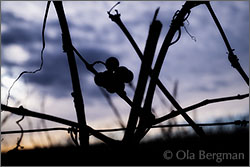 – We chose to make a cuvée of its own with this one because the top of our parcel in Les Pluchots has much more limestone and whiter than the surrounding parcels. Village Volnay usually doesn’t have this length. It was first made in 2009, because we didn’t have enough space. We had emptied a tank to put this parcel there. It was in the blend before. We used concrete tanks and it was whole bunches so it required a lot of space. Then we did it again in 2014, and after that regularly since 2017.
– We chose to make a cuvée of its own with this one because the top of our parcel in Les Pluchots has much more limestone and whiter than the surrounding parcels. Village Volnay usually doesn’t have this length. It was first made in 2009, because we didn’t have enough space. We had emptied a tank to put this parcel there. It was in the blend before. We used concrete tanks and it was whole bunches so it required a lot of space. Then we did it again in 2014, and after that regularly since 2017.
The village appellation Pommard is pretty much the opposite to its Volnay counterpart. Most of it comes from the top of the slope – Chanlins and Lambots. There is just one small parcel at the bottom, behind the Auberge des Vignes.
There is no lack of Volnay premier cru at Domaine Pierrick Bouley. There are six in total, but two of them – Ronceret and Santenots – are only produced in tiny quantities. In a good year there will be just 300 bottles of each.
– Robardelle is a premier cru at the very south of the appellation, says Pierrick Bouley. It’s on the border to Meursault. It’s down where it’s flat, not on the slope. The slope begins with Chevret, which is just above. The row orientation is north-south.
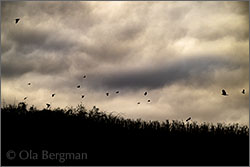 About one kilometre north of Robardelle you’ll find Les Grands Champs. This Volnay premier cru is the monopole of Domaine Pierrick Bouley. A large part – 6.75 hectares – of Les Grands Champs is village appellation. Then there is a premier cru part, which is just 0.24 hectare. This is also one of the lieux-dits which make up Les Mitans.
About one kilometre north of Robardelle you’ll find Les Grands Champs. This Volnay premier cru is the monopole of Domaine Pierrick Bouley. A large part – 6.75 hectares – of Les Grands Champs is village appellation. Then there is a premier cru part, which is just 0.24 hectare. This is also one of the lieux-dits which make up Les Mitans.
– You could call it Les Mitans, but then it wouldn’t be a monopole. Style-wise Les Grands Champs is like Robardelle. Always floral, fruity. Very Volnay and always very good young. Not very tannic. There is no reason to keep it longer than 10-15 years. Annual production is 900 bottles.
– In Robardelle there is very little soil. You are very close to the bedrock. Just 50 centimetres of soil. Les Grands Champs is different, since you have the Volnay valley up behind. So you have lots of alluvial soil at the bottom of the slope. Lots of small stones in the first five centimetres of the soil. The village appellation part of Les Grands Champs is almost only clay.
Higher up on the slope, in the middle of the appellation and 300 metres from Les Grands Champs, is Champans. The name simply means a field on a slope. This premier cru has quite deep soil, well-drained clay with pebbles.
At the top of the slope, south of the village and on the Monthelie-side of the appellation, is Clos des Chênes, a premier cru with lots of finesse.
– Clos des Chênes is facing south, says Pierrick Bouley. Much more limestone and whiter soil. We have two parcels. It’s always a wine which is serious, more structured. The two parcels are very different. One is on the slope, running from bottom to top, whereas the other is on an almost flat part with less limestone more clay.
© 2025 Ola Bergman










